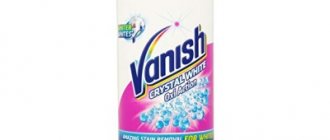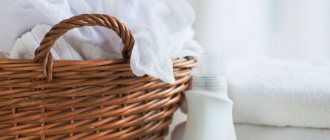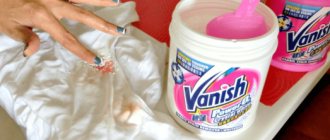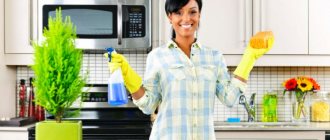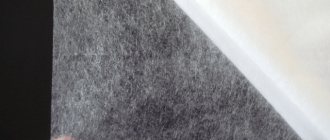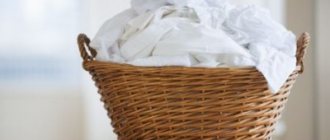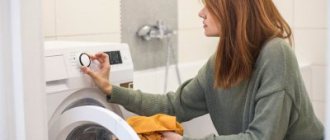- Use of oxygen bleaches
If earlier, when asked which laundry bleach is the best, any housewife would answer: “Whiteness” - but now everything is not so simple. The variety of household chemicals causes confusion for many. To find out how modern bleaches work, we decided to take a closer look at each of the existing types.
When choosing laundry detergents, check their composition and read the manufacturer’s recommendations for use.
Tip 1: Before bleaching, check the durability of the products
Before using chlorine bleach on clothing, you should test how the product behaves. Mix one teaspoon of bleach with two teaspoons of warm water. Select an inconspicuous area on the garment that is made of the same fabric as the garment itself, such as an inseam or the inside of a pocket. Using a cotton swab, apply the solution to the fabric. Leave until completely dry. If you notice a discoloration or staining of the stick to match the color of the fabric, this means that the fabric is not colorfast and should not be used with bleach.
This is especially true for clothes made of polyester, nylon and other non-natural fabrics. Chlorine bleach can turn your crisp white blouse yellow by eating away at the outer coating of the polyester fibers and exposing their inner yellow core. You don't need such metamorphoses!
Procedure for whitening in the clinic
The doctor examines the oral cavity. Tune in for 2 sessions if you have no diseases, and 3-4 or more if you have:
During the first visits, the dentist treats caries and pulpitis, takes measures to transfer gum disease from the acute and subacute stages to remission.
In dentistry, various systems are used to restore lost whiteness and shine to teeth. Zoom and Opalescence are popular.
In one procedure it brightens by 4–8 tones. Instead of hydrogen peroxide, which is used in most gels, carbamide peroxide is used here. The gel keeps the enamel intact and eliminates the chance of damage: its aggressiveness is low. It cleans plaque well. In addition, a radiation spectrum of such a length is used that makes it impossible to overheat the tooth nerve. The risk of complications is minimal.
The doctor, together with the patient, decides what shade should be given to the teeth. The dentist may advise against making teeth too white due to the risk of damage - he will see the condition of the oral cavity and what the congenital characteristics of the teeth are.
Video review from a patient at the Dr. Stepman clinic:
The following are the steps:
- Periodontal tissues, mucous membranes of the tongue, lips, and cheeks are isolated and covered with a latex plate called a rubber dam. A light-curing barrier is installed. This is required to eliminate the possibility of tissue injury.
- Bleach-n-Smile gel is applied to the crowns of the teeth.
- Activate the gel with the light of a Zoom lamp.
- The gel is applied a second time and activated again.
- If necessary, the procedure is repeated a third time.
- The gel is washed off with water.
- The teeth are coated with a special composition Super Seal. Its task is to remineralize and strengthen enamel tissue.
Looking at the photo, we see: the teeth have become 6-8 shades whiter!
Session duration is 45 minutes.
Opalescence
The technique is approximately the same. The gel base here is carbamide peroxide. When the composition is activated, oxygen is released, which, reacting with plaque and pigment molecules, removes them. The gel is activated with a special lamp. It takes 30 seconds per tooth for the plaque to decompose.
Video instructions for the Opalescence system:
Briefly and clearly about how teeth whitening occurs using a mouth guard:
Then the teeth must be coated with fluoride varnish.
Dentist advice
The doctor gives the patient home recommendations. After the procedure you should:
- refrain from eating food containing coloring pigments (coffee, beets, red wine, chocolate);
- brush your teeth carefully with a soft brush;
- do not drink or eat hot or cold food.
After 3 days, the previous sensitivity of the teeth will be restored. You can live by the old rules.
Ideally, to maintain the newly acquired shade for 2.5–3 years, the patient should:
- brush your teeth with an ultrasonic brush;
- apply floss;
- rinse your mouth after eating.
Once every six months, the doctor conducts preventive examinations.
Tip 2: Never mix different types of bleach with each other or with ammonia
Never mix chlorine bleach with oxygen bleach (often called an all-purpose bleach that preserves the color of fabrics). As a result of mixing, a chemical reaction can occur that will negatively affect your clothes, and most importantly, your lungs.
But the biggest danger is mixing chlorine bleach with household ammonia. When these substances are mixed, a dangerous chemical reaction occurs between chloramine vapor and liquid hydrazine, which can cause respiratory problems.
When to use
The main purpose of bleaching agents is to brighten. Therefore, these measures are primarily used for white items.
Some manufacturers produce special bleaches for color washing. These are soft substances that restore and maintain color. Some bleaches contain stain-removing ingredients and can deal with different types of stains.
Carefully! When choosing a whitening product, read the label carefully. If it is written that the product is intended only for white laundry, this means that it cannot be used for washing many colored items.
Tip 3: Dilute the bleach
NEVER pour chlorine bleach directly onto fabric, even if you need to bleach the item. This can cause fibers to corrode and create holes in the fabric, not to mention fading. Before adding bleach to your washing machine drum or soak container, mix about one cup of bleach in one quart of warm water. Pour some water into the washing machine drum, and only then add dirty laundry.
When using automatic detergent dispenser containers, bleach is added after the drum is filled with water. In this case, it is diluted automatically and will not damage your products.
White for floor cleaning and home disinfection
It can be used as a home and floor disinfectant, but before doing so, you must carefully review the precautions:
After learning the precautions, you can wash the floors in your house using whitewash. For this, a ratio of 1:10 is used, where 1 is bleach and 10 is water. Based on this, 100 ml of bleach is used per 1 liter of water. After washing the floor, it is recommended to rinse it again with plain water and ventilate the room well.
Tip 4: Don't add bleach right away
To allow the enzymes in laundry detergents and other laundry products to work on stains and dirt, add diluted bleach 5 minutes after the start of the wash cycle, not immediately. Adding chlorine bleach early in the cycle can reduce the effectiveness of the detergent.
Automatic detergent dispensers in washing machines are programmed to ensure that bleach is always delivered at the correct point in the cycle.
Precautions and recommendations for working with the product
Whitening using an aggressive component is only possible if the basic rules for using the product are followed. Ignoring them can end disastrously not only for the thing being processed, but also for health.
We recommend: 11 products + review of how and how to remove limescale in the bathroom
Tip: If you place a bottle of bleach on the bottom during storage, you may have problems unscrewing the cap one day. It is better to place the container on its side, carefully closing it. Some manufacturers even began to produce their product in bottles with a round bottom, specifically forcing users to take this step.
We recommend: Vanish for the sofa: how to clean any stains in no time?
All rules are easy to follow. Compliance with them guarantees the safety of textile products during processing, and the housewife – the absence of unpleasant sensations and the prevention of additional problems.
Tip 6: Observe storage conditions
Chlorine bleach is sensitive to light and temperature, so liquid bleach is always sold in opaque bottles to protect the product from light. Too high a temperature will also affect the effectiveness of the bleach, so it is very important to store it at a temperature of around 20 C.
Additionally, approximately 6 months after purchase, the product's effectiveness begins to wane, regardless of whether the bottle is opened. This does not mean that the bleach has gone bad and will cause any serious harm. No, its cleaning and disinfecting properties will simply be less effective. If you use old bleach, then consider that you are bleaching your laundry with ordinary water.
Using disinfectant properties
The disinfection mechanism of the Whiteness agent is ensured by the highly toxic property of sodium chlorate to influence harmful microorganisms. During oxidative processes, it suppresses the activity of enzyme systems in bacterial cells, which prevents their further reproduction.
Instructions for use of Whiteness recommend using a disinfectant for preventive and routine treatment:
- kitchen and utility rooms in kindergartens;
- school offices, foyers and corridors;
- medical premises, laboratories, hospital wards.
The process of destroying pathogenic organisms allows us to avoid mass diseases in the event of possible infections in these institutions.
Liquid with chlorine is good for routine cleaning of plumbing units and bathrooms . Its use effectively removes urinary stones formed on the walls of the toilet bowl. To do this, pour one liter of product into the drain passage and onto the walls of the bowl. Close the lid for 10-12 hours, and then use a brush to wash all cavities.
The truth about chlorine bleaches
Household chlorine bleach is a 5.25% aqueous solution of sodium hypochlorite. This is a fairly strong solution and must be further diluted with water so as not to damage the fabric. When you use chlorine in your laundry, the chemical oxidizes in the water and helps remove dirt and organic matter. In addition, it has disinfectant properties, killing bacteria, fungi and viruses. It also bleaches cotton, linen and other natural fabrics.
Chlorine bleach is sold in powder and liquid form. Powder can be bought both in regular and online stores.
In order to get the desired result after using bleach, take the time to read the information on the packaging, especially if your goal is disinfection. To effectively disinfect, bleach must have a sodium hypochlorite concentration between 5.25% and 6.15%. Not all manufacturers use this formula.
We hope our tips will help you always get the desired washing result!
Best lists
Above we offered you 7 whitening products with their properties, pros and cons. But we decided not to limit ourselves to this, so we are ready to present you the best representatives in the following categories:
- Budget.
- Liquid.
- For children's things.
Budget - Chirton
Purpose: white and colored linen. Looks like white powder. Sold in bags of 150 g. Consumption: 50 g per wash. If there are old stains, then the dose of bleach is doubled. Washing: automatic and manual. Removes stains and dirt from any type of fabric. Refers to oxygen-containing products.
Price: 37 - 55 rubles.
Chirton bleach
Liquid – SYNERGETIC
Sold in matte plastic bottles, 1 liter. Designed for effective bleaching of any fabrics, removes stains of any origin and complexity. You can wash baby clothes with bleach. Disinfects. Softens water. Type: oxygen-containing bleaches.
Cost: 147 - 199 rub.
bleach SYNERGETIC
For children's things - Eared nannies
The manufacturer is Nevskaya Cosmetics. Package weight: 500 g. Appearance: white powder. The product is aimed at whitening and cleaning children's underwear made of any type of fabric. Add 50 g of powder per 10 liters of water if the laundry is not very dirty. If there are stains and dirt, then 60-70 g of product per 10 liters of water. Machine wash - 130-140 g per 5 kg of laundry.
Price tag: 73 - 106 rubles.
bleach eared nannies
What types of clothes is Whiteness suitable for washing?
Before bleaching things with “Whiteness,” you need to remember that the composition of this product is very aggressive. Therefore, when starting the washing process, study the composition of the fabric and make sure that it is natural.
Important! You should not bleach synthetics, woolen and delicate fabrics, as well as leather goods, since “Whiteness” can cause the formation of yellow stains or even holes on them.
It cannot be used on colored fabrics; it can completely remove the pattern.
Important! On dense fabrics, it is better to apply whiteness pointwise, directly to the contaminated area.
Is it possible to wash dishes with Beliznoy?
Washing dishes with bleach kills harmful bacteria.
Therefore, it is recommended to treat an apartment with “Belizna” in situations where there is an infectious patient in the family.
In other cases, ordinary products are sufficient to keep dishes clean.
Important! Dishes made of silver, steel, and aluminum cannot be treated with chlorine-containing preparations.
Stages of processing dishes:
The most convenient mop for washing floors: 8 types and how to use the spin cycle
How to hand wash and soak clothes in white
All white items must be sorted before bleaching; it is best to do this by type of fabric. You also need to set aside children's clothing separately; they will need to be washed with a reduced dosage of the product, rinsing additionally several times.
Since you need to use white for bleaching with caution, you will need thick household gloves for hand washing and soaking. It is not recommended to inhale the vapors of this product, and after bleaching the room must be ventilated.
How to hand wash with white:

